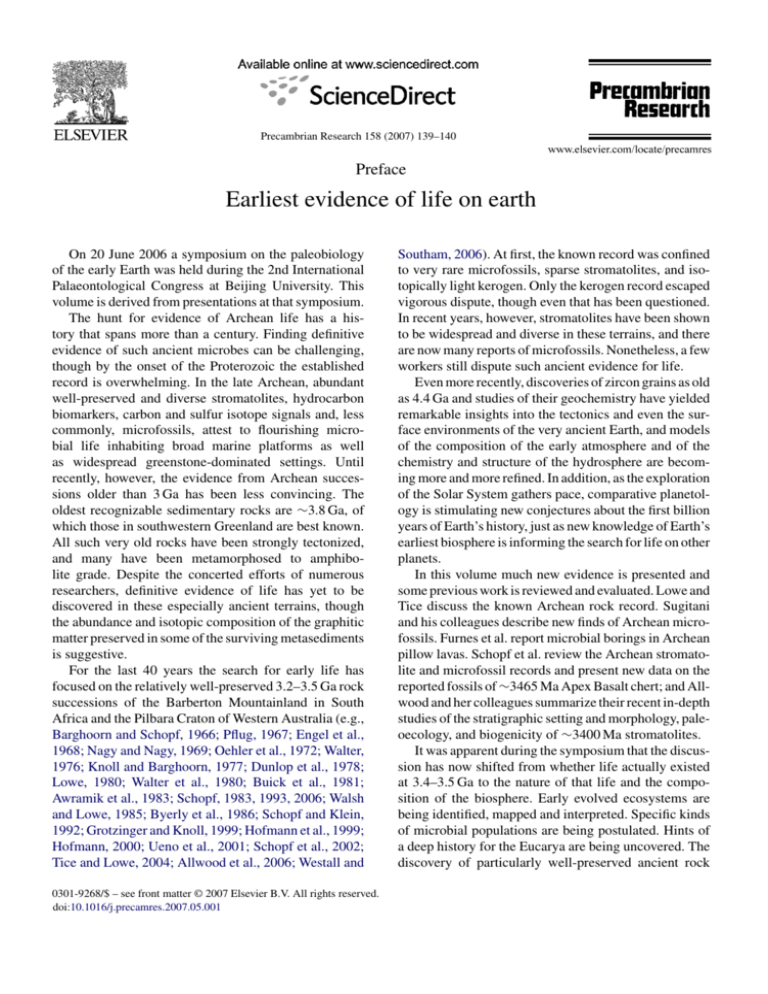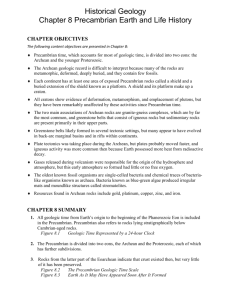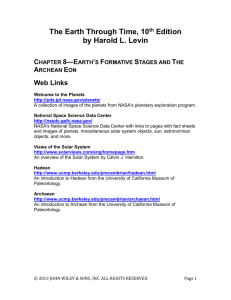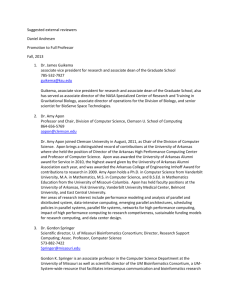
Precambrian Research 158 (2007) 139–140
Preface
Earliest evidence of life on earth
On 20 June 2006 a symposium on the paleobiology
of the early Earth was held during the 2nd International
Palaeontological Congress at Beijing University. This
volume is derived from presentations at that symposium.
The hunt for evidence of Archean life has a history that spans more than a century. Finding definitive
evidence of such ancient microbes can be challenging,
though by the onset of the Proterozoic the established
record is overwhelming. In the late Archean, abundant
well-preserved and diverse stromatolites, hydrocarbon
biomarkers, carbon and sulfur isotope signals and, less
commonly, microfossils, attest to flourishing microbial life inhabiting broad marine platforms as well
as widespread greenstone-dominated settings. Until
recently, however, the evidence from Archean successions older than 3 Ga has been less convincing. The
oldest recognizable sedimentary rocks are ∼3.8 Ga, of
which those in southwestern Greenland are best known.
All such very old rocks have been strongly tectonized,
and many have been metamorphosed to amphibolite grade. Despite the concerted efforts of numerous
researchers, definitive evidence of life has yet to be
discovered in these especially ancient terrains, though
the abundance and isotopic composition of the graphitic
matter preserved in some of the surviving metasediments
is suggestive.
For the last 40 years the search for early life has
focused on the relatively well-preserved 3.2–3.5 Ga rock
successions of the Barberton Mountainland in South
Africa and the Pilbara Craton of Western Australia (e.g.,
Barghoorn and Schopf, 1966; Pflug, 1967; Engel et al.,
1968; Nagy and Nagy, 1969; Oehler et al., 1972; Walter,
1976; Knoll and Barghoorn, 1977; Dunlop et al., 1978;
Lowe, 1980; Walter et al., 1980; Buick et al., 1981;
Awramik et al., 1983; Schopf, 1983, 1993, 2006; Walsh
and Lowe, 1985; Byerly et al., 1986; Schopf and Klein,
1992; Grotzinger and Knoll, 1999; Hofmann et al., 1999;
Hofmann, 2000; Ueno et al., 2001; Schopf et al., 2002;
Tice and Lowe, 2004; Allwood et al., 2006; Westall and
0301-9268/$ – see front matter © 2007 Elsevier B.V. All rights reserved.
doi:10.1016/j.precamres.2007.05.001
Southam, 2006). At first, the known record was confined
to very rare microfossils, sparse stromatolites, and isotopically light kerogen. Only the kerogen record escaped
vigorous dispute, though even that has been questioned.
In recent years, however, stromatolites have been shown
to be widespread and diverse in these terrains, and there
are now many reports of microfossils. Nonetheless, a few
workers still dispute such ancient evidence for life.
Even more recently, discoveries of zircon grains as old
as 4.4 Ga and studies of their geochemistry have yielded
remarkable insights into the tectonics and even the surface environments of the very ancient Earth, and models
of the composition of the early atmosphere and of the
chemistry and structure of the hydrosphere are becoming more and more refined. In addition, as the exploration
of the Solar System gathers pace, comparative planetology is stimulating new conjectures about the first billion
years of Earth’s history, just as new knowledge of Earth’s
earliest biosphere is informing the search for life on other
planets.
In this volume much new evidence is presented and
some previous work is reviewed and evaluated. Lowe and
Tice discuss the known Archean rock record. Sugitani
and his colleagues describe new finds of Archean microfossils. Furnes et al. report microbial borings in Archean
pillow lavas. Schopf et al. review the Archean stromatolite and microfossil records and present new data on the
reported fossils of ∼3465 Ma Apex Basalt chert; and Allwood and her colleagues summarize their recent in-depth
studies of the stratigraphic setting and morphology, paleoecology, and biogenicity of ∼3400 Ma stromatolites.
It was apparent during the symposium that the discussion has now shifted from whether life actually existed
at 3.4–3.5 Ga to the nature of that life and the composition of the biosphere. Early evolved ecosystems are
being identified, mapped and interpreted. Specific kinds
of microbial populations are being postulated. Hints of
a deep history for the Eucarya are being uncovered. The
discovery of particularly well-preserved ancient rock
140
Preface / Precambrian Research 158 (2007) 139–140
units and the application of new and improved analytical techniques are yielding a wealth of new information.
One thing is clear: there will be an explosion of research
and new findings in the coming decade that will greatly
improve our understanding of early life on Earth.
References
Allwood, A.C., Walter, M.R., Kamber, B.S., Marshall, C.P., Burch,
I.W., 2006. Stromatolite reef from the Early Archaean era of Australia. Nature 441, 714–718.
Awramik, S.M., Schopf, J.W., Walter, M.R., 1983. Filamentous fossil
bacteria from the Archean of Western Australia. Precam. Res. 20,
357–374.
Barghoorn, E.S., Schopf, J.W., 1966. Microorganisms three billion
years old from the Precambrian of South Africa. Science 152,
758–763.
Buick, R., Dunlop, J.S.R., Groves, D.I., 1981. Stromatolite recognition
in ancient rocks: an appraisal of irregular laminated structures in an
early Archean chert-barite unit from North Pole, Western Australia.
Alcheringa 5, 161–181.
Byerly, G.R., Lowe, D.R., Walsh, M.M., 1986. Stromatolites from
the 3,300–3,500-Myr Swaziland Supergroup, Barberton Mountain
Land, South Africa. Nature 319, 489–491.
Dunlop, J.S.R., Muir, M.D., Milne, V.A., Groves, D.I., 1978. A new
microfossil assemblage from the Archaean of Western Australia.
Nature 274, 676–678.
Engel, A.E.J., Nagy, B., Nagy, L.A., Engel, C.G., Kremp, G.O.W.,
Drew, C.M., 1968. Algalike forms in Onverwacht Series, South
Africa: oldest recognized lifelike forms on earth. Science 161,
1005–1008.
Grotzinger, J.P., Knoll, A.H., 1999. Stromatolites in Precambrian carbonates: evolutionary mileposts or environmental dipsticks? Annu.
Rev. Earth Planet. Sci. 27, 313–358.
Hofmann, H.J., 2000. Archean stromatolites as microbial archives.
In: Riding, R.E., Awramik, S.M. (Eds.), Microbial Sediments.
Springer, Berlin, pp. 315–327.
Hofmann, H.J., Grey, K., Hickman, A.H., Thorpe, R.I., 1999. Origin
of 3.45 Ga coniform stromatolites in Warrawoona Group, Western
Australia. Geol. Soc. Am. Bull. 111, 1256–1262.
Knoll, A.H., Barghoorn, E.S., 1977. Archean microfossils showing cell
division from the Swaziland System of South Africa. Science 198,
396–398.
Lowe, D.R., 1980. Stromatolites 3,400-Myr old from the Archean of
Western Australia. Nature 284, 441–443.
Nagy, B., Nagy, L.A., 1969. Early Precambrian Onverwacht
microstructures: possibly the oldest fossils on earth? Nature 223,
1226–1229.
Oehler, D.Z., Schopf, J.W., Kvenvolden, K.A., 1972. Carbon isotopic studies of organic matter in Precambrian rocks. Science 175,
1246–1248.
Pflug, H.D., 1967. Structured organic remains from the Fig Tree Series
(Precambrian) of the Barberton Mountain Land (South Africa).
Rev. Palaeobot. Palynol. 5, 9–29.
Schopf, J.W. (Ed.), 1983. Earth’s Earliest Biosphere—Its Origin and
Evolution. Princeton University Press, Princeton, NJ, 453 pp.
Schopf, J.W., 1993. Microfossils of the Early Archean Apex chert: new
evidence of the antiquity of life. Science 260, 640–646.
Schopf, J.W., 2006. Fossil evidence of Archaean life. Phil. Trans. Roy.
Soc. B 361, 869–885.
Schopf, J.W., Klein, C. (Eds.), 1992. The Proterozoic Biosphere—A
Multidiscliplinary Study. Cambridge University Press, New York,
1348 pp.
Schopf, J.W., Kudryavtsev, A.B., Agresti, D.G., Wdowiak, T.J., Czaja,
A.D., 2002. Laser-Raman imagery of Earth’s earliest fossils.
Nature 416, 73–76.
Tice, M.M., Lowe, D.R., 2004. Photosynthetic microbial mats in the
3,616-Myr-old ocean. Nature 431, 549–552.
Ueno, Y., Isozaki, Y., Yurimoto, H., Maruyama, S., 2001. Carbon
isotopic signatures of individual Archean microfossils(?) from
Western Australia. Int. Geol. Rev. 43, 196–212.
Walsh, M.M., Lowe, D.R., 1985. Filamentous microfossils from
the 3500-Myr-old Onverwacht Group, Barberton Mountain Land,
South Africa. Nature 314, 530–532.
Walter, M.R. (Ed.), 1976. Stromatolites, Developments in Sedimentology 20. Elsevier, Amsterdam, 790 pp.
Walter, M.R., Buick, R., Dunlop, J.S.R., 1980. Stromatolites
3,400–3,500 Myr old from the North Pole area, Western Australia.
Nature 284, 443–445.
Westall, F., Southam, G., 2006. Early life on Earth. In: Benn, K. (Ed.),
Archean Geodynamics and Environments. Am. Geophys. Union
Geophys. Monograph, 283–384.
J. William Schopf ∗
University of California, Los Angeles, CA, USA
Malcolm R. Walter
Macquarie University, Sydney, Australia
Cao Ruiji
Nanjing Institute of Geology and Palaeontology, China
∗ Corresponding
author. Tel.: +1 310 825 1170;
fax: +1 310 825 0097.
E-mail address: schopf@ess.ucla.edu
(J.W. Schopf)









